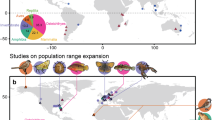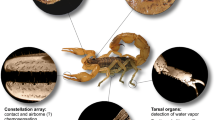Abstract
Authors currently disagree as to whether random scatter, familiarity with a large area, or navigation is the basic mechanism of homing in rodents. Starting from the behavior of animals that fail to home, I present a new hypothesis based on motivational factors, which could explain the observed decreases of homing success that occur with increasing distances in rodents and other animals, irrespective of the possible mechanisms involved. I also suggest that consideration of the behavior of nonhomers is essential in attempts to explain homing.
Access this chapter
Tax calculation will be finalised at checkout
Purchases are for personal use only
Preview
Unable to display preview. Download preview PDF.
Similar content being viewed by others
References
Anderson, P.K., Heinsohn, G.E., Whitney, P.H., Huang, J.P,: Mus musculus and Pero-myscus maniculatus: homing ability in relation to habitat utilization. Can. J. Zool. 55, 169–182 (1977)
Bovet, J.: Influence d’un effet directionnel sur le retour au gîte des mulots fauve et sylvestre (Apodemus flavioollis Melch. et A. sylvatious L.) et du campagnol roux (Clethrionomys glareolus Schr.) (Mammalia, Rodentia). Z. Tierpsychol. 19, 472–488 (1962)
Bovet, J.: Displacement distance and quality of orientation in a homing experiment with deer mice (Peromysous manioulatus). Can. J. Zool. 50, 845–853 (1972)
Cooke, J.A., Terman, C.R.: Influence of displacement distance and vision on homing behavior of the white-footed mouse (Peromysous leuoopus noveboraoensis), J. Mammal. 58., 58–66 (1977)
Davis, R.: Homing performance and homing ability in bats. Ecol. Monogr, 36, 201–237 (1966)
DeBusk, J., Kennerly, Jr., T.E.: Homing in the cotton rat, Sigmodon hispidas Say and Ord. Am. Midl. Nat. 93, 149–157 (1975)
Fisler, G.F.: Homing in the California vole, Miorotus californicus. Am, Midl. Nat. 68, 357–368 (1962)
Fisler, G.F.: Homing in the western harvest mouse, Reithrodontomys megalotis. J. Mammal. 47, 53–58 (1966)
Furrer, R.K.: Homing of Peromysous manioulatus in the channelled scablands of east-central Washington. J. Mammal, 54, 466–482 (1973)
Harrison, J.L.: Range of movement of some Malayan rats. J. Mammal. 39, 190–206 (1958)
Mueller, H.C.: Homing and distance orientation in bats. Z. Tierpsychol. 23, 403–421 (1966)
Murie, M.: Homing and orientation of deer mice. J. Mammal. 44, 338–349 (1963)
Murie, O.J., Murie, A.: Travels of Peromysous. J. Mammal, 12, 200–209 (1931)
Robinson, W.L., Falls, J.B.: A study of homing of meadow mice. Am. Midl, Nat. 73, 188–224 (1965)
Saint Girons, M.C., Durup, M.: Retour au gîte chez le mulot, Apodemus sylvaticus, et le campagnol roussâtre, Clethrionomys glareolus. Facteurs écologiques, apprentissage et mémoire. Mammalia 38., 389–404 (1974)
Stickel, L.F.: An experiment on Peromysous homing. Am. Midl. Nat. 41, 659–664 (1949)
Wallraff, H.G.: Über die Flugrichtungen verfrachteter Brieftauben in Abhängigkeit vom Heimatort und vom Ort der Freilassung. Z. Tierpsychol. 27, 303–351 (1970)
Wilkinson, D.H.: The random element in bird “navigation”. J. Exp. Biol. 29, 532–560 (1952)
Wilson, D.E., Findley, J.S.: Randomness in bat homing. Am. Nat. 106, 418–424 (1972)
Author information
Authors and Affiliations
Editor information
Editors and Affiliations
Rights and permissions
Copyright information
© 1978 Springer-Verlag Berlin Heidelberg
About this paper
Cite this paper
Bovet, J. (1978). Homing in Wild Myomorph Rodents: Current Problems. In: Schmidt-Koenig, K., Keeton, W.T. (eds) Animal Migration, Navigation, and Homing. Proceedings in Life Sciences. Springer, Berlin, Heidelberg. https://doi.org/10.1007/978-3-662-11147-5_40
Download citation
DOI: https://doi.org/10.1007/978-3-662-11147-5_40
Publisher Name: Springer, Berlin, Heidelberg
Print ISBN: 978-3-662-11148-2
Online ISBN: 978-3-662-11147-5
eBook Packages: Springer Book Archive




